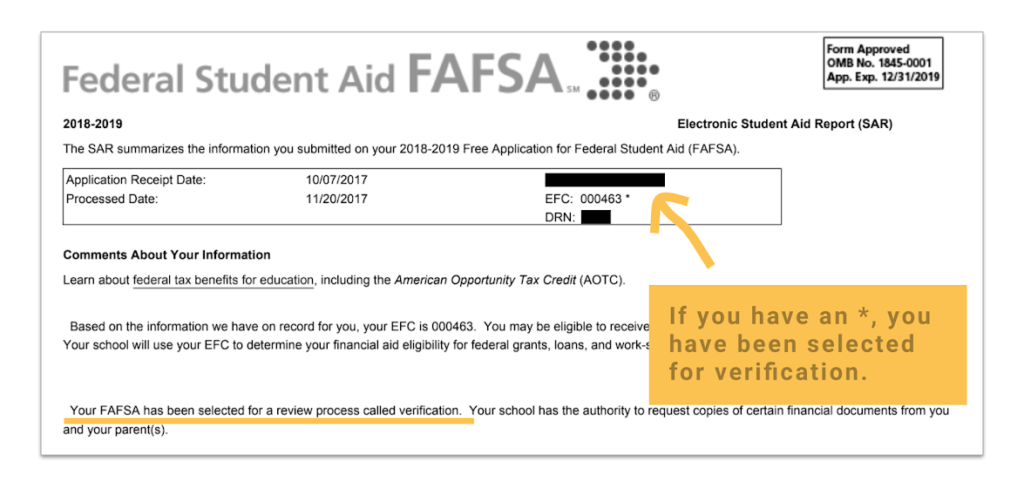The U.S. Federal Government or state governments, colleges, career schools, and private or non-profit organizations offer various financial aid for students planning to attend a college or career school. To avail of these aids, as a first step, you need to submit a form called the FAFSA (Free Application for Federal Student Aid) that determines your eligibility to access these.

How Financial Aid Works?
Basic Eligibility Criteria
To qualify for getting any financial aid, you need to demonstrate specific essential eligibility criteria. They include:
- Should have a financial need.
- Must be a U.S. citizen or an eligible non-citizen.
- Must hold a valid social security number.
- Must be enrolled or accepted as a regular student in a certificate or other suitable program.
- Must be eligible for Direct Loan program funds.
- Must maintain satisfactory academic progress in college or career schools.
You should satisfy the below requirements and sign the FAFSA form accordingly:
- You are not a federal student loan defaulter.
- You do not owe money on a federal student grant.
- You will use federal student aid only for educational purposes
You must be qualified to obtain a college or career school education:
- Having a high school diploma or a recognized equivalent such as a General Educational Development (GED) certificate.
- Completing a high school education in a homeschool setting approved under state law
Suppose you meet the essential eligibility criteria for federal student aid. In that case, the financial aid office of your school or college will determine the amount you shall receive based on:
- Expected Family Contribution
- Your year in school
- Your enrollment status
- The cost of attendance at the school you will be attending.
The below formula is used to calculate your financial need:
Cost of Attendance (COA) − Expected Family Contribution (EFC) = Financial Need
If you don’t have a financial need, your eligibility for non-need-based financial need is calculated as below:
Cost of Attendance (COA) − Financial Aid Awarded So Far* = Eligibility for Non-need-based Aid
Once you are offered a financial aid offer from a specific school, you need to compare it with various other offers from other schools, provided you have applied. This way, you can reduce yourself to finding the most affordable college or school. In addition, accept the financial aid offers in the order given below to gain the most benefits out of it:
- Free money first (e.g., scholarships, grants)
- Earned money second (e.g., work-study)
- Borrowed money last (e.g., federal student loans)
Types of Financial Aid
Federal Grants
Federal grants are monetary aid given to students to help them pay for their college or career school. These grants don’t have to be repaid unless the situation calls for it. However, only specific scenarios demand you to compensate all or part of a federal grant, such as the below:
When to Repay a Grant?
- A program for which you enrolled and claimed the grant but withdrew early.
- When your enrollment status changes, it impacts your eligibility for the grant. For example, while you shift from full-time enrollment to part-time, your grant amount is reduced accordingly.
- If you have already availed of an outside scholarship or grant, it reduces the need for federal student aid.
- If you were awarded a TEACH grant, you couldn’t satisfy its service obligations.
Grant Repayment
In case your grant has to be repaid, your university or school will notify you if you have to pay it in whole or settle with a satisfactory repayment arrangement. In such a scenario, you have to pay the debt within 45 days from the date of issue, failing to become ineligible to avail of further federal student aid. However, if you enter into a satisfactory repayment arrangement, the Education Department will take over the debt allowing you to repay through the school.
Grant Eligibility
Grants are mainly offered to students who require financial assistance. Submit a FAFSA form every year while still in school to continuously receive federal student aid. Based on the type of grant, your eligibility requirements vary. Therefore, the different types of grants are listed below.

Types of Grants
The U.S. Department of Education offers different grant programs for students attending four-year colleges or universities, community colleges, and career schools.
Federal Pell Grants
Eligibility Criteria
To avail of Federal Pell Grants, you have to be:
- An undergraduate student with high financial requirements.
- A student who has not earned a bachelor’s, graduate, or professional degree.
- A student enrolled in a postbaccalaureate teacher certification program.
However, you will not be eligible for the Federal Pell Grants:
- If you were penalized by a federal or state institution and imprisoned.
- If you had been a sexual offender who had completed a year of imprisonment.
Once you are found eligible for a Federal Pell Grant, you can expect to get the total amount you are entitled to receive, provided your school participates in the program organized by the U.S. Department of Education. You can get paid directly or through your school costs or both ways.
How much money to expect?
The maximum Federal Pell Grant award for 2021-22 is $6,495. For a year-round Pell, you may be eligible to receive up to 150 percent of your scheduled amount for an academic year. Additionally, if you qualify for any other student aid, you will still receive the eligible amount of your Federal Pell Grant. However, you cannot avail it from more than one school in an academic year. Further, the amount you receive from this grant varies yearly as per the:
- Your predicted family contribution
- Your school’s determination of the cost of attendance for your specific program.
- Your status as a full-time or part-time student.
- Your plan of attendance for the entire academic year.
Additionally, you get a more significant Federal Pell grant, with the EFC set to zero, if one of your parents lost their life in Iraq or Afghanistan, or while on duty as a public safety officer, provided you are:
- Less than 24 years of age
- Enrolled in college or career school at least part-time.
In case of a high EFC, if your parents served in the military in Iraq or Afghanistan, you may be eligible to get an Iraq and Afghanistan Service Grant.
What should I do to maintain the grant?
You can stay eligible for the grant in the following ways:
- You must maintain your admission at the undergraduate nonforeign school.
- Fill out the FAFSA form every year while in school.
However, your eligibility automatically expires when you earn a baccalaureate degree or your first professional degree or have used up all 12 terms of your eligibility.
Federal Supplemental Educational Opportunity Grants (FSEOG)
Eligibility Criteria
To avail of FSEOG, you have to be:
- An undergraduate student with exceptional financial needs.
The Financial aid office directly manages the FSEOG program on the premises of the participating schools. Therefore, it operates quite differently when compared to the Federal Pell Grant. To avail of this grant, you need to fill out the FAFSA form and apply it as early as possible as its availability depends on the funds at your school. Once your eligibility is confirmed, you will be paid directly or through your student account. Generally, schools pay this grant semester-wise or quarterly, or at least twice per academic year.
How much money to expect?
This grant pays you between $100 and $4,000 a year, assessing the below-mentioned scenarios when you apply:
- Your financial need
- The amount of other aid you get
- The availability of funds at your school.
Additionally, once a school’s FSEOG-allotted funds are awarded to students, they cannot be further available for that year. So, it is essential to know the deadlines for campus-based funds either from the website or the financial aid office.
What should I do to maintain the grant?
You can stay eligible for the grant in the following ways:
- You must maintain your admission at the undergraduate non-foreign school.
- You should not have earned a bachelor’s degree previously.
- Fill out the FAFSA form annually
Iraq and Afghanistan Service Grants
Eligibility Criteria
You are eligible to receive the Iraq and Afghanistan Service grant provided you satisfy the following requirements:
- You have a high EFC, making you ineligible for a Federal Pell Grant.
- If you are a student without a bachelor’s, graduate, or professional degree.
- A student enrolled in a postbaccalaureate teacher certification program.
- Your parent or guardian was a part of the U.S. armed forces and lost their life due to military service performed in Iraq or Afghanistan.
- You were less than 24 years old or enrolled in at least part-time college at the time of your parent’s or guardian’s death.
Once you satisfy the eligibility criteria, you will be paid like a Federal Pell Grant.
How much money to expect?
You can expect an amount equal to the maximum Federal Pell Grant for the award year. However, the grant award will not exceed your cost of attendance for that reward year.
What should I do to maintain the grant?
- Fill out the FAFSA form annually.
However, your eligibility automatically expires when you earn a baccalaureate degree or first professional degree or have used up all 12 terms of your eligibility.
Teacher Education Assistance for College and Higher Education (TEACH) Grants
A TEACH grant is offered when you agree to complete a teaching service. However, when you fail to meet the teaching service, your grant will be converted to a loan that you have to repay with interest.
Eligibility Criteria
To receive a TEACH Grant, you must be:
- Eligible to receive federal student aid.
- Enrolled in a school that participates in the TEACH program as an undergraduate, post-baccalaureate, or graduate student.
- Should have enrolled in a TEACH-Grant-eligible program.
- Meet specific academic achievement requirements.
- Undergo TEACH grant counseling.
- Sign a TEACH Grant Agreement to Serve or Repay.
Conditions to Receive a TEACH Grant
- Work as a full-time highly-qualified teacher at a school that serves low-income students.
- Teach in a high-need field such as mathematics, science, foreign language, reading specialist, bilingual education, English language acquisition, or special education.
- Complete the required four years of teaching within eight years after graduation, or otherwise, cease to be enrolled.
How much money to expect?
You can avail of up to $4,000 a year through TEACH grants and begin a career in teaching.
Scholarships
Organizations like schools, employers, individuals, private companies, non-profits, and communities offer scholarships. You don’t have to repay a scholarship as subsidies are awarded to you. Generally, a scholarship helps you cover the tuition fees and reduces your cost of education. Once granted a scholarship, you have to inform your school as it affects your other student aid. The sum of your student aid should be less than the cost of your attendance. You can earn scholarships based on:
- Merit
- Financial Needs
- Particular groups of people Eg: women, graduate students
- People from specific backgrounds or work Eg: military families
Additionally, you can avail yourself the information about scholarships from:
- A financial aid office
- A public library
- Online
Federal Work-Study Jobs
If you are an undergraduate or graduate student in need of financial assistance, you can avail yourself of the federal work-study jobs offered part-time or full-time. This way, you can earn and meet your educational expenses at college or career school. In addition, you will be employed either on-campus or off-campus and engaged in community service or other works related to your course. Additionally, if you wish to apply for work-study jobs, ensure you apply early to avail yourself of the limited funds.

How much can I earn?
Depending on the type of work you are engaged in, you can earn at least the current federal minimum wage or more. Your earnings depend on:
- The time of your application
- Your level of financial need
- Your school’s funding level
How will I be paid?
Based on your request, you will be paid through your bank account, or you can request the school to use the funds for your educational charges at the institution. In addition, being a graduate or an undergraduate influences the amount you get. Your earnings will not be more than your total federal work-study award.
Loans
A loan is an amount you borrow and repay with interest. When you avail a loan from a federal government, these loans are termed federal student loans. These loans are more beneficial than those borrowed from private firms such as banks and other financial institutions. There are different types of loans offered by the federal government. They include:
- Direct Subsidized loans: Only undergraduate students can avail of this loan, provided they demonstrate financial assistance.
- Direct Unsubsidized Loans: This loan can be availed by undergraduate, graduate, and professional students irrespective of their financial needs.
- Direct Plus Loans: Graduate or professional students and parents of dependent undergraduate students can avail of this loan irrespective of their financial needs. However, they have to undergo a credit check prior to their qualification.
- Direct Consolidation Loans: This allows you to combine all federal student loans into a single loan.

Aid for military families
The federal government and non-profit organizations offer financial assistance for educational purposes of those rendering their services in the navy, army, military, or related to someone in duty.
Aid for international study
If you wish to pursue your education at a global place of study, abroad, or anywhere outside the U.S., you are still eligible to receive monetary funds.
How to Complete the FAFSA Form?
In general, you need to apply for the FAFSA form to avail the various types of aids available for educational purposes. The steps mentioned below help you navigate the process with ease.
Step 1: Create an FSA ID
Create an FSA ID with a suitable username and password combination. This allows you to:
- Sign your FAFSA form electronically
- Access the myStudentAid app
- Sign loan contracts
- Access certain information online

You can avoid processing delays when you create an FSA ID and then fill out the FSA form. This way, while you fill your form, you will be asked to enter the FSA ID about the student. Once you enter your I.D., some relevant information will be automatically loaded to your application. In addition, you can avoid common errors due to the mismatch between the verified FSA ID and the information in the FSA application.
How to Create an Account Username and Password (FSA ID)
Step 2: Collect the Necessary Documents to Apply
The FAFSA application process is designed to receive your:
- Personal information
- Financial information
Hence, it requires documents that support the information you furnish. They include:
- Your Social Security number; For dependent students, parents’ numbers are required.
- If you are not a US citizen, your alien registration number is required.
- Your driver’s license number if you have one.
- Federal tax information or tax returns.
- Records of your untaxed income.
Step 3: Filling your FAFSA Form and Providing Basic Information
- Apply online through the fafsa.gov website.
- Apply through the myStudentAid mobile app, available on the App Store (iOS) or Google Play (Android).
- Take a printout of the 2022-23 FAFSA PDF, fill it up and mail it for processing.
- Call 1-800-4-FED-AID (1-800-433-3243) to request a printout, fill it up, and send it for processing.
If you are applying through the mobile apps for the first time,
- Be prepared with the FSA ID as the app doesn’t allow you to fill the same without it.
- Select the FAFSA form from the menu or on the dashboard.
- Fill in your role.
- Click on “Start a New FAFSA Form.”
Step 4: Listing Colleges or Career Schools
Once you fill-up the application, you will be required to list schools or career schools of your choice in the FAFSA form. This will help the schools decide the type and the amount of financial aid needed for you. The federal student aid you receive does not depend on the order in which you list the schools. However, some state aids are mindful of listing the schools or colleges.
In online and apps, you can list up to 10 schools, whereas, in FAFSA PDF, you can list only four schools. Your applications reach these schools electronically.
Step 5: State Your Dependency Status
If you are a dependent student, you must furnish your parental information. On the contrary, if you are an independent student, you need to provide your financial information.
Below is the financial information you may need to give:
- Information from tax forms
- Balances of savings and checking accounts.
Step 6: Signing and Submitting Your FAFSA FORM
Try to fill out the online application
- Sign in with your FSA ID
- Fill in the required details in the form
- Take a printout of the form
- Mail in a signature page to the listed address.
- If you furnish your email address on the FAFSA form, you will receive the confirmation page by email automatically.
- Alternatively, you may have to print or save your confirmation page before you exit.
what to do after completing the FAFSA FORM?
Ensure your form is processed
Once you submit your form, you need to know its status, which will be any one of the below:
- Processing: This state means that your application is being processed. Typically, it takes three to five days, plus one additional business day, for your form to be available to the schools you listed.
- Missing Signatures: Check out for missing required signatures.
- Action Required: When you have missed adding some details to the application.
- Processed Successfully: This indicates your application was processed successfully.
Once successfully processed, you will receive the SAR or the Student Aid Report (SAR) from three days to three weeks post your submission. It is the summary of the FAFSA report you submitted, which you can make corrections to if necessary.
If you have been accepted at any of your chosen colleges or career schools, the school calculates your aid and sends you an award letter. This letter tells you the financial assistance you are eligible to claim and its timing which may be before the start of school or as early as winter.

In addition, you might be informed of your selection for verification through the SAR or your chosen college. Your school carries out the process of confirmation to verify if your FAFSA data matches your actual documents. For this purpose, your school may request additional records.

After the FAFSA: What Happens Next
Final Thoughts
Whether you want to pursue your career in school or college education, it is possible with a federal student aid program. First, however, ensure you furnish the accurate details in the FAFSA form. Once your form is successfully processed, you may have to go through the student report summary and reflect on your mistakes if available.












